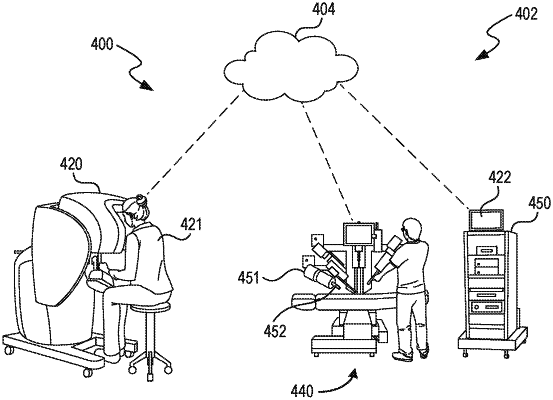| CPC G16H 20/40 (2018.01) [G05B 19/4155 (2013.01); G06N 20/00 (2019.01); G16H 40/67 (2018.01); G05B 2219/40269 (2013.01); G05B 2219/45123 (2013.01)] | 21 Claims |

|
1. A method for operating a surgical robotic system using edge computing, the method comprising:
causing, by a control system of a surgical robot, the surgical robot to robotically position one or more sensors to capture images of a surgical site, wherein the surgical robot comprises a robotic arm;
generating, by an artificial intelligence (AI) accelerator of the control system, a prediction of an adverse surgical event, using a machine learning (ML) model, based on the images of the surgical site received from the one or more sensors, the prediction indicating that insertion of a first implant would touch non-targeted tissue at the surgical site;
in response to the prediction of the adverse surgical event, transitioning control of the surgical robot to an edge computing system, wherein the edge computing system performs steps comprising:
generating, by the AI accelerator, instructions for controlling the surgical robot via the edge computing system to avoid the adverse surgical event during robotic surgery,
wherein the AI accelerator of the edge computing system generates the prediction and the instructions on-the-edge while avoiding concurrent data transfer to a computer system over a network, and
wherein the instructions direct insertion of a second implant different from the first implant to avoid touching the non-targeted tissue by the second implant;
moving, by robotic joints of the robotic arm, the robotic arm to perform robotic telesurgery, wherein the robotic arm is communicably coupled to the edge computing system;
positioning, by the surgical robot, the robotic arm in a configuration based on the instructions, the configuration defined by a spatial position and an orientation;
performing, by the surgical robot, at least one action to avoid the adverse surgical event when the robotic arm is positioned in the configuration;
determining the adverse surgical event was avoided by the surgical robot; and
in response to determining the adverse surgical event was avoided, transitioning control of the surgical robot from the edge computing system to the control system.
|